Table of Contents
In this blog post, you will learn about interjections, which are words or phrases used to express strong emotions or sudden reactions. Interjections can show surprise, joy, excitement, or frustration and are often followed by an exclamation mark. They stand alone or at the beginning of a sentence to add emotional impact. We will cover the definition, different types of interjections, and simple examples to help you understand them better.
What is Interjection?

A word or phrase that expresses sudden emotion, often stands alone, and ends with an exclamation mark or comma.
Examples:
Ah! That feels so much better.
Oh no! I forgot my keys.
Yay! We won the game!
Using Interjections at the Beginning of a Sentence
In most cases, interjections appear at the beginning of a sentence to set the tone. For example:
- Wow! This painting is beautiful.
- Oh no! I left my wallet at home.
1. Using Interjections in the Middle of a Sentence
Sometimes, interjections can be inserted in the middle of a sentence for emphasis. This helps to capture a reaction right where it’s felt, rather than waiting until the end of a sentence.
- The party was, well, a bit disappointing.
- I forgot, oops, to send the invitation.
2. Using Interjections at the End of a Sentence
Interjections can also appear at the end of a sentence, often to emphasize a reaction to what was just said.
- That’s a huge achievement, yay!
- I didn’t expect to win, whoa!
3. Using Punctuation with Interjections
Since interjections stand alone, they’re usually followed by a comma for a softer tone or an exclamation mark for stronger feelings.
- Hmm, I’m not sure about this.
- Wow! That’s incredible news.
Comma use suggests mild reactions like Hmm (hesitation), while an exclamation mark indicates excitement, surprise, or strong emotion with Wow!
Types of Interjections
Interjections come in various types, each conveying a different kind of emotion or reaction. Understanding these types can help you use them effectively in conversations and writing.
1. Exclamatory Interjections
These express sudden emotions like surprise, excitement, or amazement. They’re perfect for adding energy to your sentences.
- Wow! That’s a beautiful view.
- Yay! We won the game.
2. Emotive Interjections
Emotive interjections are used to show feelings such as happiness, sadness, or frustration. They help to express emotions naturally and instantly.
- Alas! The play got canceled.
- Oh no! I missed the deadline.
3. Cognitive Interjections
These interjections reflect thoughts or hesitation. They’re useful when you’re considering something or need a moment to think.
- Hmm, let me think about it.
- Well, I guess that’s one option.
4. Volitive Interjections
Volitive interjections convey commands or requests, often used to urge or warn someone quickly.
- Shh! Please be quiet in the library.
- Hurry! We’re running late.
5. Greeting Interjections
These are simple interjections for greeting or saying farewell. They make interactions feel friendlier and more conversational.
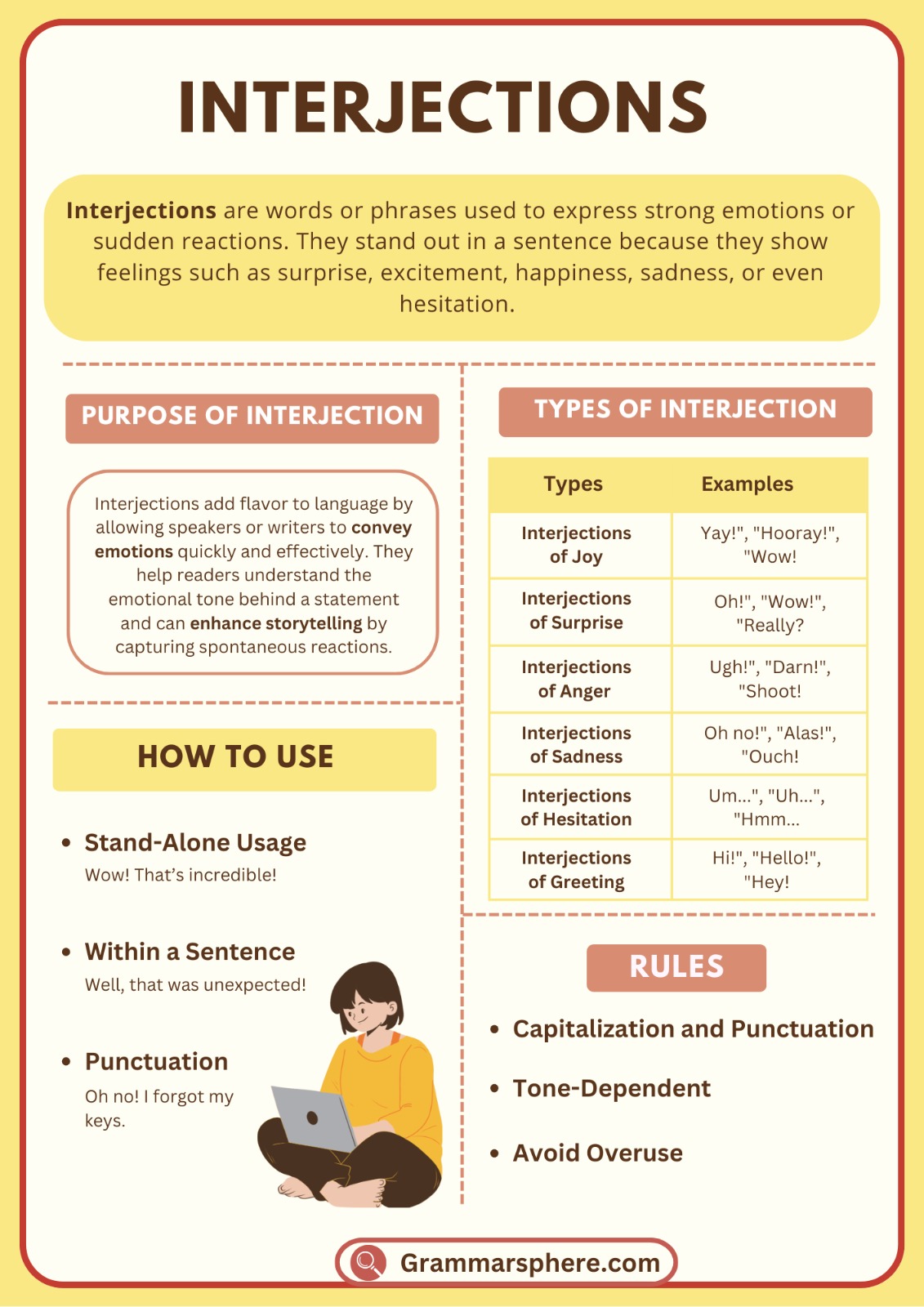
Interjection Example Sentences
- Wow! That performance was incredible.
- Oh no! I forgot my keys at home.
- Yay! We’re finally on vacation.
- Oops! I made a mistake on the form.
- Hmm, I’m not sure about that answer.
- Bravo! You did an amazing job.
- Well, I think it’s time to leave.
- Shh! Please don’t disturb the class.
- Ouch! That really hurt my hand.
- Hey! Wait for me!
- Oops! I accidentally spilled the juice.
- Alas! The last episode is over.
- Hello! It’s so nice to meet you.
- Goodbye! Take care and stay safe.
- Phew! That was a close call.
Primary interjection vs Secondary Interjection
Interjections come in two main types: primary interjections and secondary interjections. While they both express emotion, their usage and structure are slightly different.
1. Primary Interjections
Primary interjections are single words with no other meaning beyond expressing emotion. They are short, direct, and easy to use in everyday language.
- Wow! That’s an amazing view.
- Oops! I didn’t mean to step on your foot.
- Yay! We finally arrived.
2. Secondary Interjections
Secondary interjections are words with a normal meaning but express emotion in certain contexts. Unlike primary interjections, they can also function as nouns, verbs, or adjectives.
- Great! You finished on time.
- Oh! That’s why it didn’t work.
- Well, I suppose we could try that.
Interjections as Sounds
Some interjections are sounds that imitate real-life noises or reactions, adding emotion and realism to speech or writing. They bring energy and personality to conversations and storytelling.
Common Sound-Based Interjections
Here are a few examples of sound-based interjections and how they’re used:
| Interjection | Expression | Example Sentence |
|---|---|---|
| Achoo! | Expresses a sneeze | Achoo! I think I caught a cold. |
| Huh? | Shows confusion or lack of understanding | Huh? I didn’t catch that last part. |
| Eek! | Expresses surprise or fright | Eek! There’s a spider on the wall! |
| Mmm | Expresses satisfaction or enjoyment (often related to taste) | Mmm, this soup is delicious. |
| Phew | Signals relief after a tense moment | Phew, I thought I’d lost my keys. |
| Grr | Mimics a growl, showing frustration or anger | Grr, I can’t believe I made that mistake again. |
| Ah | Shows realization, satisfaction, or relief | Ah, now I understand what you mean. |
Using Sound-Based Interjections Effectively
Sound-based interjections are especially useful in storytelling and casual conversations. They make descriptions more dynamic and allow you to show rather than tell emotions. They can also add humor, drama, or excitement, making your language more engaging.
- In a casual conversation, you might say: Ugh! This traffic is terrible.
- In storytelling: Crash! The vase shattered on the floor, startling everyone.
Interjection vs Exclamation
| Aspect | Interjections | Exclamations |
|---|---|---|
| Definition | Words or phrases that express sudden emotions or reactions. | A sudden, loud expression of strong emotion, often in speech or writing. |
| Grammar Role | Stand alone, not grammatically linked to a sentence. | Can be full sentences or phrases, often with a subject and verb. |
| Examples | Wow!, Oops!, Aha!, Ouch! | What a beautiful day!, I can’t believe it!, Help! |
| Purpose | Adds emotion and feeling to speech or writing. | Emphasizes strong emotions or urgency. |
| Punctuation | Usually followed by ! or , (e.g., “Oops, I dropped it.”) | Usually followed by ! (e.g., “That’s amazing!”) |
Key Difference:
- Interjections are often single words expressing emotion.
- Exclamations can be longer expressions or full sentences showing strong feelings.
Why Interjections Are Important
Interjections like Wow!, Oops!, or Yay! quickly express emotion or reaction, making speech lively and real. They help convey surprise, excitement, or frustration instantly.
For example, saying “Oh no!” after a mistake instantly shows your feelings. Interjections add warmth and help learners express emotions clearly and naturally.
You May Also Like



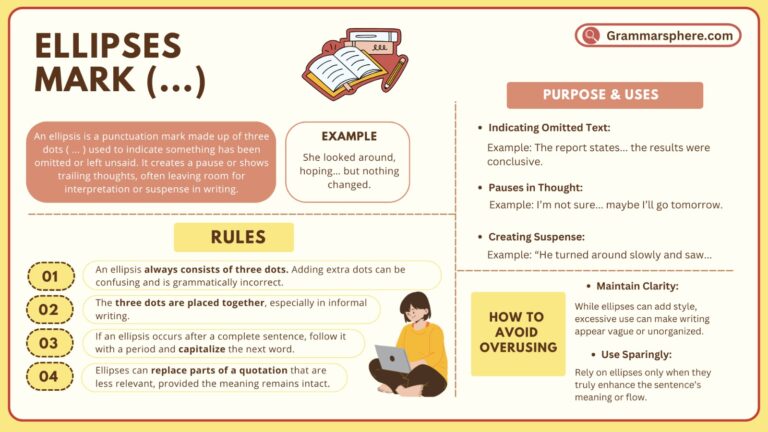

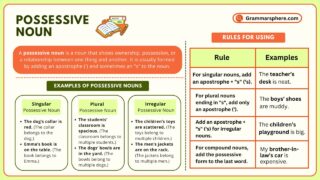
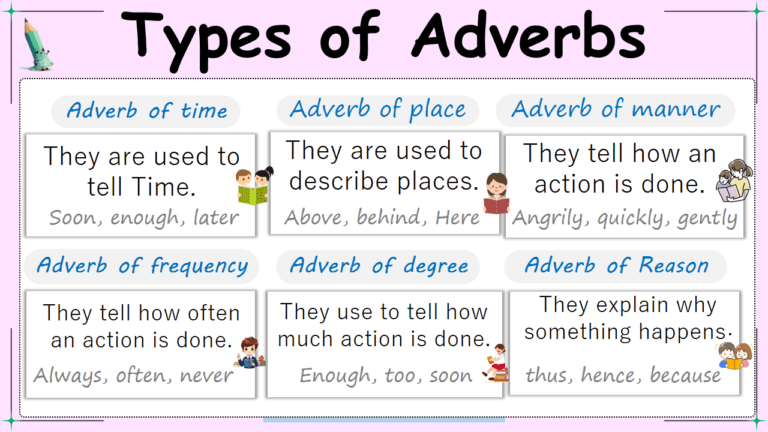

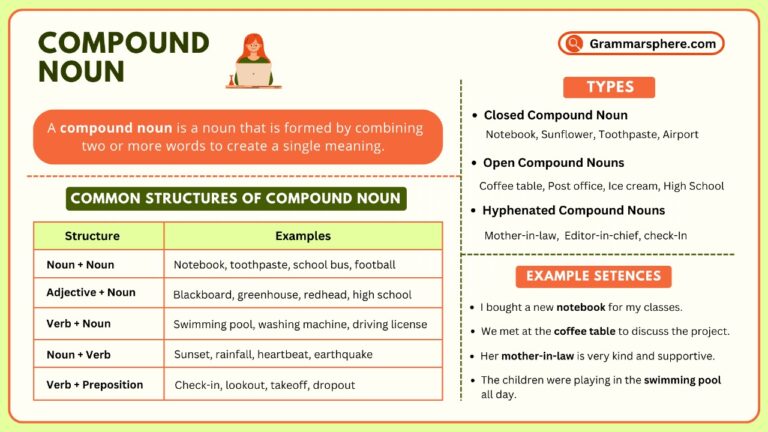
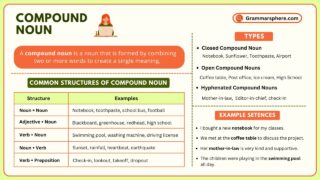
Leave a Comment